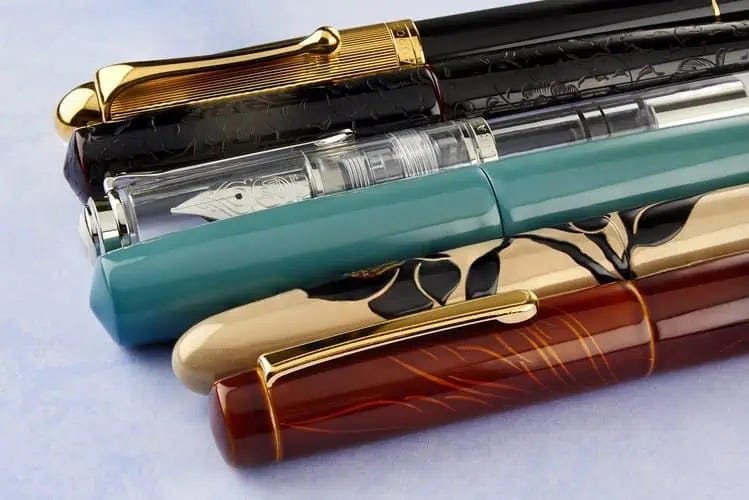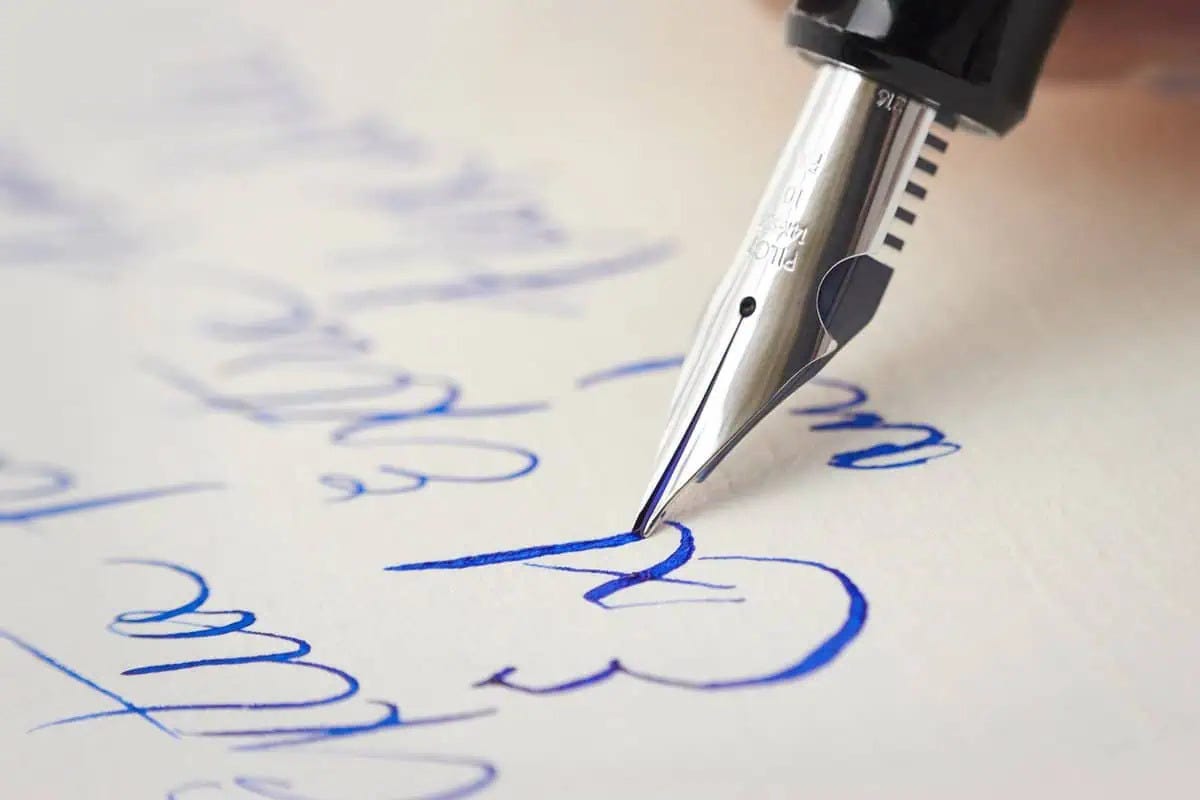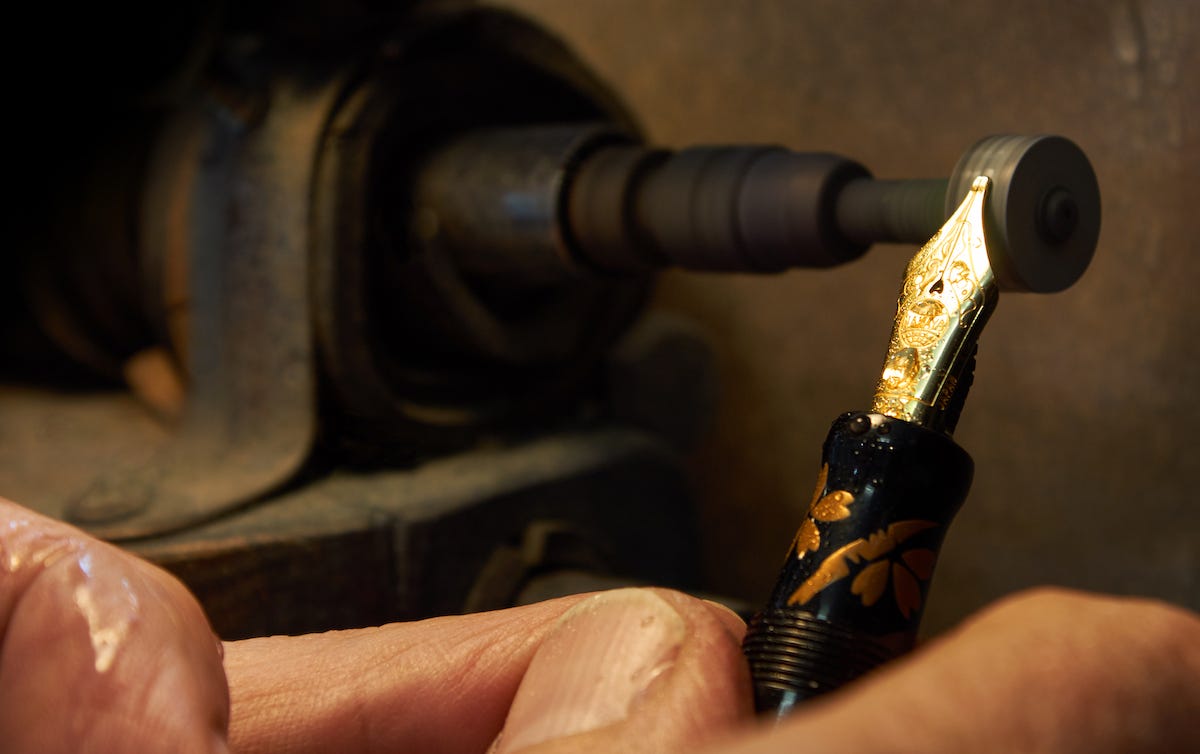The Moral Lessons of a Fountain Pen
From timeless designs to artful inks, fountain pens offer much more than a simple method for putting words on paper: They illustrate the lasting values of craftsmanship.
The Moral Lessons of a Fountain Pen
Story by , Publisher and Editor-in-Chief
Back in the day—in this case, from the early 1900s to around 1950—if someone wanted to write anything down with permanence, they reached for a pen of the kind one rarely sees anymore.
These were called fountain pens, and their highly refined nibs (that inch-long piece at the pen’s business end, which delivers ink in a controlled, liquid flow and is often made of real gold) were tiny works of art. The way such a pen wrote was so sophisticated, and delivered such tactile pleasure and guidance, with every letter, that it almost taught the writer fine penmanship all by itself. (To see what I mean, take a glance at this popular video of a master calligrapher playing with a fountain pen.)
Contrast that to the pens of today. If you want to write something down (and I mean really write something, by hand), I’ll wager the best you have on hand is a plastic pen with a ballpoint or rollerball ink cartridge. That pen will certainly get the job done, but unless your handwriting is exceptional, the lettering it produces cannot make a visual statement of distinction. And it isn’t what you’d call a fun tool to use. Once it runs out of ink, even if it takes a refill, I will also wager that you don’t have a refill on hand, and won’t bother to buy one. Instead, you will toss this pen, which was purposely designed to be disposable, into the trash.
The old fountain pens, which were decidedly not designed to be disposable, were not cheap. In the 1940s (when their perfection peaked), they ranged from less than $20, by today’s values, to well beyond $100. That sounds like a rich person’s hobby, but it’s actually quite the opposite. This hidden truth was perhaps best explained by one of our writers, Tim Redmond, in a delightful story we published some years ago, entitled ”The Perfect Pen.”
Back in 1985, when he was a young reporter in San Francisco, struggling to make rent, Redmond walked into an art supply store and paid $120 for a Montblanc, which is still regarded by many as the Cadillac of fountain pens. “My friends thought I was nuts,” Redmond writes. “That was, literally, half a month’s rent, a month’s groceries. A pack of ten ballpoint pens went for a buck; what on Earth was I thinking?”
What Redmond might have been thinking about is the hidden value in quality. Over the decades, he estimates, his Montblanc has “filled at least 3,000 reporter’s notebooks, 1,000 or so legal pads, and written more than 1,900 checks.” By his tally, this luxury item has cost him $3.75 a year. Meanwhile, the rest of the world turned to disposable pens, leading to some 1.6 billion plastic pens going into the landfill every year, just in the U.S. And that doesn’t count the many more finding their way into our oceans and fresh waterways, where they add to the growing accumulation of toxic micro-chemicals.
The issues raised by a simple pen go well beyond the environment and economics. When experts aim to define works of craftsmanship, they commonly focus on three terms: beauty, functionality, and durability. On each of these principles, fountain pens deliver bounteously, on a level that a ballpoint pen could never match.
So why did we toss the mighty fountain pen aside in favor of cheap throwaways? The answer boils down to a pair of reasons, the same troublesome twins that create problems in almost every round of product redesign: convenience and cost.
The cost question we’ve pretty much addressed, but there’s a point in the numbers worth noting: the disposable pen’s lure of lower cost, as is so often the case, involves up-front cost; it is the genius of industry to always find a way to hide an enterprise’s long-term costs.
Now, let’s turn to cost’s evil twin: convenience.
Yes, keeping a fountain pen filled is more trouble than buying a Bic or Pilot pen. You need bottles of ink, which must be used with care; the same goes for keeping a pen from leaking when you’re carrying it around. But think for a moment about the physical investment and close attention that a fountain pen demands. Those considerations actually produce a kind of spiritual gift. In a world increasingly dominated by the virtual, aren’t we hungry for something over which we have complete agency, and complete responsibility? If we lose our tactile connection to the workings of all the stuff in our lives, don’t we also lose some of what make us human? Looked at this way, $120 for a pen really is a bargain.
If you enjoyed this story, you might also like…
The Artisan's Paradox
by
It's a curious truth: In a world dominated by mass production, the finest handmade goods often cost less than their factory-made counterparts.
The Perfect Pen
by Tim Redmond
Fountain pens have always served as the quintessential combination of beauty, tradition, and dexterity. From our archives, a tour of the fountain pen’s history, infinite varieties, and remarkable powers.
Craftsmanship Magazine focuses on master artisans and innovators whose work informs our quest: to create a world built to last. In addition to our Substack offerings, you’ll find a rich archive of stories, podcasts, photo essays, and documentary shorts on our free website—along with community resources like our Artisans’ Directory, our guide to U.S.-based craft & folk schools, and much more.











Just wanted to second Rich's comment.
Being a lefty was always a penmanship nightmare.
I know that there are "lefty" nibs but truthfully handwriting was designed to have the pen be pulled across the page the beginning of the word to the end. left to right with a nice slant.
Leftys have to push the pen into the word having the pen tip dig into the paper.
I remember in third grade when learning "cursive writing" having my teacher show me how to contort my hand and arm into a pretzel,
Not fun
I love fountain pens, the style, the craftsmanship etc. Unfortunately as a lefty and with horrid handwriting I can only admire them